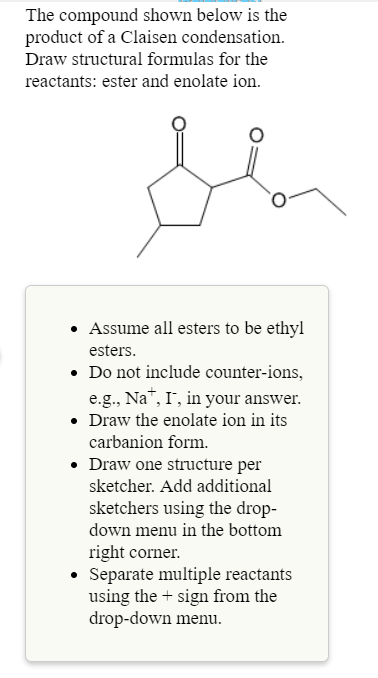The compound shown below is the product of a Claisen condensation. Draw structural formulas for the reactants: ester and enolate ion. Assume all esters to be ethyl esters . Do not include counter-ions . Draw the enolate ion in its . Draw one structure per e.g., Na, I, in your answer. carbanion form. sketcher. Add additional sketchers using the drop- down menu in the bottomm right corner. Separate multiple reactants using the + sign from the drop-down menu
Reactive Intermediates
In chemistry, reactive intermediates are termed as short-lived, highly reactive atoms with high energy. They rapidly transform into stable particles during a chemical reaction. In specific cases, by means of matrix isolation and at low-temperature reactive intermediates can be isolated.
Hydride Shift
A hydride shift is a rearrangement of a hydrogen atom in a carbocation that occurs to make the molecule more stable. In organic chemistry, rearrangement of the carbocation is very easily seen. This rearrangement can be because of the movement of a carbocation to attain stability in the compound. Such structural reorganization movement is called a shift within molecules. After the shifting of carbocation over the different carbon then they form structural isomers of the previous existing molecule.
Vinylic Carbocation
A carbocation where the positive charge is on the alkene carbon is known as the vinyl carbocation or vinyl cation. The empirical formula for vinyl cation is C2H3+. In the vinyl carbocation, the positive charge is on the carbon atom with the double bond therefore it is sp hybridized. It is known to be a part of various reactions, for example, electrophilic addition of alkynes and solvolysis as well. It plays the role of a reactive intermediate in these reactions.
Cycloheptatrienyl Cation
It is an aromatic carbocation having a general formula, [C7 H7]+. It is also known as the aromatic tropylium ion. Its name is derived from the molecule tropine, which is a seven membered carbon atom ring. Cycloheptatriene or tropylidene was first synthesized from tropine.
Stability of Vinyl Carbocation
Carbocations are positively charged carbon atoms. It is also known as a carbonium ion.
The compound shown below is the product of a Claisen condensation. Draw structural formulas for the reactants: ester and enolate ion.
- Assume all esters to be ethyl esters.
- Do not include counter-ions, e.g., Na+, I-, in your answer.
- Draw the enolate ion in its carbanion form.
- Draw one structure per sketcher. Add additional sketchers using the drop-down menu in the bottom right corner.
- Separate multiple reactants using the + sign from the drop-down menu.

Trending now
This is a popular solution!
Step by step
Solved in 2 steps with 1 images






